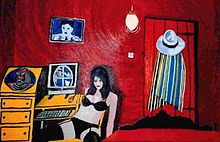|
Philip Absolon
Philip Absolon (born 24 November 1960) is a British artist and a founder member of the Stuckists art group,[1] exhibiting in the group shows, including The Stuckists Punk Victorian at the Walker Art Gallery in 2004,[2] and taking part in Stuckist demonstrations against the Turner Prize.[3] He has had long-term unemployment problems, depicted in his work with imagery of skeletons; his other main subject is cats, which he studies and depicts in motion.[3] Life and careerPhilip Absolon was born in Erith, Kent, and is the great-great-grandson of the Victorian watercolourist John Absolon (1815–1895).[1] He attended Rede School, Strood, and Educational Special Unit, Chatham (he is dyslexic).[1] 1977–79, he was at the Foundation Art course, Medway College of Art and Design,[1] along with future Stuckist artists, Billy Childish and Bill Lewis, who in 1979 formed The Medway Poets performance group with Charles Thomson and three others.[4] This group—with which Absolon read, although he was not a formal member[3]— was the core of the Stuckism art group founded in 1999.[5]  1979–82, he did a Diploma course at Epsom College of Art, where his paintings were thrown in a skip on the orders of the Principal.[1] 1982–93 was spent either unemployed or in job training schemes for computer or office work.[1] In 1984, his application for the Slade School of Art was rejected, and so in 1987 was his application for the Royal College of Art, to which he submitted pictures of cats.[1] 1993–94, he was on a Fine Art Access course at Maidstone College of Art, then accepted for a part-time degree, which financial constraints made him unable to accept; he was then awarded a grant for a full-time course, but his application was rejected.[1] In 1999, he was accepted for an NVQ in horse care, which he could not finish as he had to undertake a mandatory Government Project Work placement.[1] Childish provided a source of support during Absolon's difficult times.[6]  In 1999, he was one of the founder members of the Stuckists art group, launched by Thomson and Childish; he has regularly exhibited in Stuckist shows, and also participated in most of the group's demonstrations against the Turner Prize at Tate Britain.[3] 2003–04, he was Artist-in-Residence at the Rochester Adult Education Centre, Kent.[1] In 2004, he was one of the fourteen "founder and featured" artists in The Stuckists Punk Victorian held at the Walker Art Gallery for the Liverpool Biennial.[2]  John Davies, a Liverpool Church of England vicar chose Absolon's Job Club as his picture of the month in February 2005, saying, "Of all the striking paintings in The Stuckists: Punk Victorian exhibition ... Philip Absolon's hit me hardest. I get the impression a lot of Stuckists are well used to life on society's fringes, on the receiving end of welfare-to-work policies which just don't work for many. Absolon's pictures – many in this style and on this theme – seem born out of the awful experience of sitting in places like Job Clubs and feeling, well, skeletal, living dead."[7] In July 2006, he was selected by Matt Price for the Saatchi Gallery Your Gallery: Critic's Choice.[8] Price said:
Absolon was one of the ten "leading Stuckists"[9] in the Go West exhibition at Spectrum London gallery in October 2006. He travels Europe by train in order to visit art museums and palaces. He has a strong interest in the German Hohenzollern Empire (1871–1918), and likes The Arts Club in Mayfair, London.[1] He lives in a cottage in Norfolk, England.[10] ArtAbsolon has drawn regularly since he was sixteen, and still attends courses on sculpture, life drawing and painting.[1] He always carries a sketch book with him, drawing, for example, customers in cafés.[11] He studies cats in movement and draws them.[1] Cats and skeletons are the main subjects in his work,[3] which can be compared to Outsider Art, but has much greater depth.[12] His working method is to enlarge the original drawing on a photocopier and then trace it onto the canvas with dressmaker's tracing paper. He usually paints from 8 to 10 at night. One of his paintings may take up to a month to complete.[1] He described the origin of his painting, Job Club:
Gallery
See alsoReferences
External linksWikimedia Commons has media related to Philip Absolon. |
||||||||||||||||







